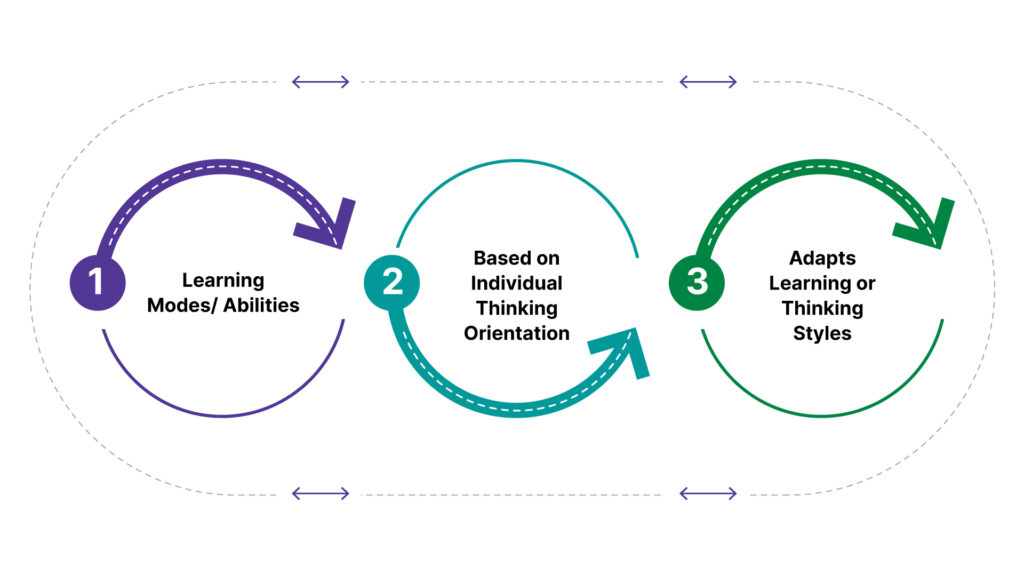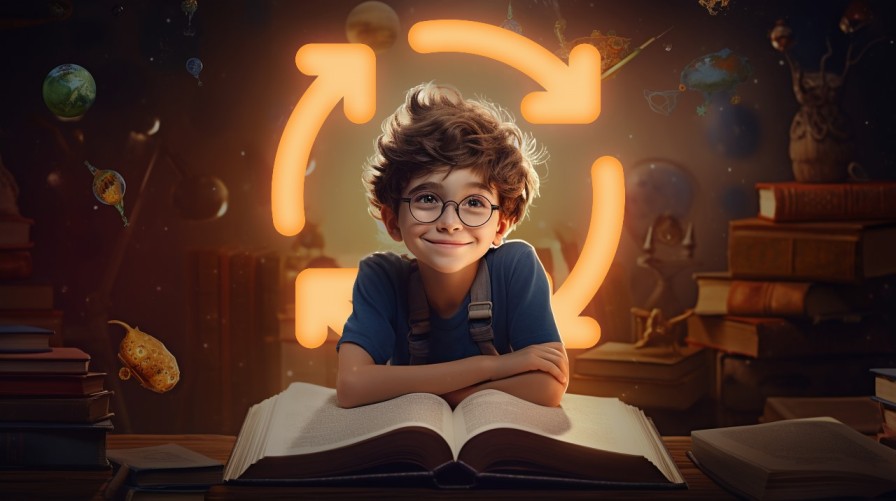“Learning is the byproduct of the activity of the learners” – John Dewey
Learning is a continuous process and the things once acquired as knowledge or skill in a particular situation become the basic instrument that helps us understand and deal with a similar situation in future, but for new fresh results. In simple words, it is either learning, relearning or unlearning to experience progress.
“That past experience has indeed not been useless, but its use is not in guiding present conduct by past situations. We must put everything we can into each fresh experience, but we shall not get the same things out which we put in if it is a fruitful experience”– Mary Parker Follet (Pioneer in Organizational Theory).
As discussed in a previous blog on “Flexible Learning Style: Key to Unfolding the Capabilities of Our Children”, the four learning modes/abilities within the experiential learning cycle, which we will discuss in detail here; are the governing factors for a dynamic experiential learning process.

The above-shown learning process of any individual is not linear, it’s more circular and depending on the situation the respective styles and their respective modes will be used. Before we go ahead, we will quickly understand the expert studies on different ways of learning.
Expert theories on ways we learn
As per expert studies, there are fundamentally different views of learning; the behavioural theories of learning are based on the conditioning of our past experiences or based on practical first-hand experiences we had in the past rather than theoretical; cognitive or implicit theories of learning which says; children as they grow up, develop cognitive frameworks or models of the world around them in their minds, to understand or reason in their new ecosystem or experience. e.g.: – Swiss Psychologist Piaget’s theory of Cognitive development in Children, where he identifies four major stages of Cognitive growth in children with milestones like (0 to 2 years) where the learning is predominantly on feeling, touching and handling; then (2 to 6 years) where the child collects representational images of the world around them and so on.
And then comes the thoughts on the Experiential model of learning, which is a more holistic view that sees learning as a cycle of experience, perception, cognition and behaviour; which means it encompasses the cognitive and behavioural aspects of learning along with other implicit forms of learning in individuals.
Since I strongly believe, a child’s true potential is a derivative of the right experience a child is put through; in this blog, we will focus on understanding the learning abilities of a child from an experiential learning perspective.
How do we define a Learning Cycle?
According to experiential learning theory, learning is defined as a process whereby knowledge is created through the transformation of experience. Or, knowing something is a result of the combination of a grasping and transforming experience; which we call a learning cycle.
Learning Cycle = Grasping Experience + Transforming Experience
So, grasping is the process of acquiring certain information and transforming is how a child interprets or acts upon it. With this in mind, the two learning modes used for grasping information are: –
- Concrete experience
- Abstract Conceptualization
The way we grasp information through an experience is through abstract or by relying on conceptual interpretation or symbolic representations; a process called comprehension (Abstract Conceptualization). Also, we grasp information through immediate experience through tangible means or feelings which are represented as apprehensions (Concrete Experience or memory).
And the two learning modes used for transforming experience are: –
- Reflective Observation
- Active Experimentation
Thus, the information grasped first, is then transformed in two opposed ways; either by internal reflection (Reflective Observation) or by external action (Active Experimentation). These different ways of acting on the information grasped are based on the orientation of the individual too.
Note: The orientation of an individual is shaped by multiple factors which include personality type, interest, curiosity and passion. We will discuss more on this below.
Understanding Learning Abilities/Modes in detail:
- Concrete Experience: It is a feeling or emotion as opposed to thinking, it’s about a memory created from a situation dealing with it personally. It involves a more intuitive approach as opposed to a scientific one. People with this orientation of learning can function well in unstructured situations and will approach life with
an open mind. - Reflective Observation: This mode of understanding involves carefully observing the meaning of a situation or idea without being impartial to past theories or events. People with this orientation are generally good at looking at a situation from different perspectives and will be enormously patient and impartial.
- Abstract Conceptualization: Here it’s more of thinking logically about something as opposed to feeling or emotion. More than intuitive, here the individual will have an orientation to build general theories with a scientific approach. A person with this orientation would be very good at planning, and quantitative analysis and will help maintain a disciplined system.
- Active Experimentation: This mode is all about the ability to act on an idea or to move ahead in any situation without any inhibition and learn on the go in an agile manner. People with this orientation will be more optimistic and they will be willing to take more risks to achieve their objectives.
Also Remember: – Different Learning styles that we discussed earlier use only one or two of the above learning abilities and not all of them; hence the reason why usually children are not very comfortable with different learning styles in their childhood.
How Internalizing information (Grasp + Transform) is dependent on individual orientation too: –
Knowledge results from the combination of grasping experience and transforming it.
So, according to the orientation of the individual, internalized knowledge could be in four different forms as below [Reference: Guilford’s structure of intellect model for the creative process and Kolb Theory, KLSI inventory 4.0]: –
Convergent –If we apply it to only solve a particular problem and have no emotional attachment to that particular knowledge or wisdom. [Dominant Learning abilities are Abstract Conceptualization & Active Experimentation]. A convergent-oriented thinker has a more deciding style by nature and chooses from the best option available for closing something or taking an action.
Divergent – If we ideate or imagine more possibilities from it. [ Dominant Learning abilities are Concrete Experience & Reflective Observation]. A Divergent-oriented Thinker would have an imagining style for creating new ideas or perspectives. These people have an artistic approach and would be looking at the information from a bigger picture. This orientation is very good for brainstorming sessions: A good manager or leader should be able to shift their orientation in thinking between convergent and divergent according to the situation.
Assimilative – Just relate it with abstract principles or hypothesis. [Dominant Learning abilities are Abstract Conceptualization & Reflective Observation]. An assimilative-oriented thinker has a strong preference for reflective conceptualization, which is more of an Analyzing style. So basically, through assimilation, we only fit new experiences into our existing concepts or schemas that we can relate to.
Accommodative – If we acted upon it and worked on the ideas generated without any inhibition. [Dominant Learning abilities are Concrete experience & Active Experimentation]. An accommodative-oriented thinker has an initiating style and emphasizes active learning. With this orientation, we can fit in new experiences by adjusting our existing schemas /concepts or create new ones through accommodation.
*Important*: So, you could notice that based on how we act upon information, the knowledge will be accordingly internalized and thus we move from novice to master on the subject we are learning.
Please note: Personality types also matter in describing how we are oriented when it comes to learning; like an extrovert would be more interested in reaching a decision and solving issues based on facts or concrete events available at hand; whereas an introvert type would emphasize gathering more information before making a decision. (Reference: Check out Jung’s psychological types for differences in human adaptive processes.)
Conclusion:
Many individuals feel that their learning style is attributed to one or two forms alone and that’s how they learn most of the time, irrespective of the situation. Then there are others who tend to adjust their learning styles based on the situation. These types of learners are more flexible in learning and this flexibility is achieved because of their ability to learn through different modes within the learning cycle.
So, a typical, learning cycle involving all modes of learning will include immediate or concrete experiences (feelings or visual images in your memory) which form the basis for observations or reflections; then, these reflections are assimilated into abstract concepts from which or how we can act ahead is crafted.
Thus, to achieve optimal learning performance, the art is to master the different learning abilities or modes that would adapt us to change a learning style, in response to a particular learning situation.

